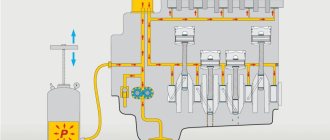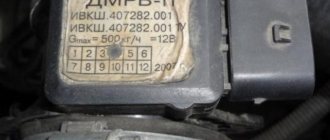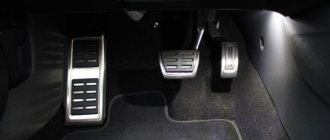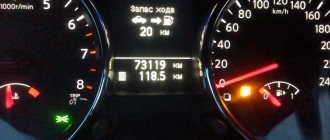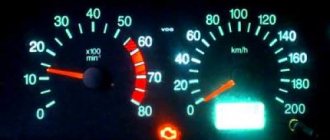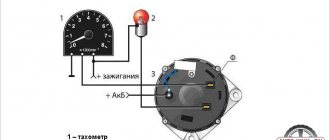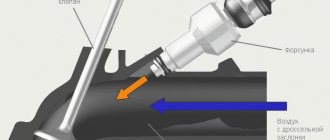The car's dashboard displays all the parameters necessary for the driver to operate the vehicle comfortably and safely. One of the most important indicators is the rotation speed of the crankshaft, which is measured using a tachometer.
This parameter allows you to control the load to which the engine is exposed and change gear in time. If the rotation indicator is not displayed or the result is unreliable, you need to find out why the tachometer is not working and determine the main ways to restore the damaged sensor.
General information
A tachometer is a device that measures the speed of rotation of rotating structural elements or individual mechanisms. This type of sensor is widely used in the automotive industry.
The main task of this device in the design of the machine is to measure the engine shaft speed. Also, some vehicles may use auxiliary tachometers, for example, to measure wheel speed.
Tachometers are used on vehicles with both manual and automatic transmissions. Using this device, the driver receives information about the functioning of the engine. It is read from the sensor and displayed on a screen or mechanical dial located on the dashboard. The unit of measurement is the number of revolutions per minute.
Each engine type has its own minimum and maximum load indicators. Therefore, the recommended number of revolutions varies. Deviation from normal rotation speed leads to accelerated wear of engine components, which increases the risk of premature breakdowns.
Monitoring engine operation taking into account tachometer data allows you to:
- increase the service life of the motor;
- reduce the load on the vehicle chassis;
- optimize fuel consumption;
- more effectively control the speed limit on different sections of the road;
- reduce the load on the transmission during gear changes.
The tachometer in a vehicle performs important functions, and therefore it is recommended to monitor the serviceability of this sensor and record violations in its operation.
Part selection rules
You can install this unit yourself. To do this you will need the following tools and materials:
First you need to find out the operating principle of the unit in question. The pulses read by this device enter the ignition system coil, displaying information on the screen. Auto mechanics recommend buying an electronic tachometer. When choosing this device, you should take into account the structural features of the VAZ 2105. Otherwise, the tachometer will show revolutions with a slight error. You can install a universal unit with switches. To do this, connect it to any type of engine.
In the selection process, you should also take into account the fact that there are dial and electronic tachometers. You can install the first type tachometer with a tuner. The second type includes the Balsat TX-319t model. It is a microprocessor device whose main task is to monitor the operation of the engine. If necessary, the driver can select the most suitable mode. Before you figure out how to install a tachometer, you need to consider the vehicle's capabilities:
- measurement of crankshaft revolutions of 2-6 and 8-cylinder engines,
- availability of watches,
- ability to remember maximum and minimum temperatures,
- presence of a stopwatch,
- ability to measure crankshaft acceleration.
Installing an electronic tachometer involves independently adjusting the backlight. The advantages of the Balsat TX-319t among auto mechanics include the presence of a standby mode. This feature significantly reduces energy costs.
How to connect a tachometer of this type is of interest to many car owners. First, select a mounting location. The negative wire is then connected to the vehicle body. The plus wire is connected to the corresponding ignition terminal. A voltage of 12 W appears in it.
How does the tachometer work?
To understand how the rotation sensor works, you need to determine how the engine functions. It is based on the process of converting translational energy into rotational energy. When the volume of gas expands inside the chamber, the pistons are activated, which are responsible for rotating the shaft. It is the speed of rotation of this shaft that is read by the tachometer.
The moment you press the gas pedal, the volume of fuel entering the chamber increases. The pressure on the piston block increases, the shaft rotates more intensely, and the speed of movement increases. Consequently, the indicator that is displayed on the panel increases.
The design of a standard tachometer includes the following components:
- Rotation sensor. It is located directly next to the crankshaft. The function of the sensor is to read the number of revolutions, which are converted into an electrical signal.
- Display block. This is a dial or screen that displays the rotational speed recorded by the sensor. The intermediate element is a converter that interprets the received electrical signal and converts it into an understandable unit of measurement.
It should be noted that the tachometer is an imprecise measuring instrument. The average error in measurements is up to 500 rpm. On the most accurate rotation sensors, the maximum error is up to 100 rpm.
Main types
Car tachometers are classified depending on the type of design. There are analogue and digital types. There are also mechanical tachometers, but they are not currently used in the automotive industry. These sensors were installed on the first vehicles.
Main types:
- Analog. They are considered more convenient and reliable. When displaying the number of revolutions, a mechanical dial with an arrow moving along it is used. The design includes a motion sensor that responds to shaft rotation. When registering revolutions, an electrical impulse is created, which subsequently overcomes the converter and causes the dial hand to move to the desired speed value. Despite a number of advantages, analog tachometers are considered less accurate.
- Digital. The sensor reads the speed of revolutions, creating numerous pulse signals. They are processed in an analog-to-digital converter and later displayed on an electronic dial or on-board computer screen. Digital models are equipped with their own microprocessor and are much more accurate than analog ones. Used on most cars manufactured after 2000.
Analog tachometers are considered obsolete. Therefore, they are found mainly in outdated cars. Unlike digital ones, they are less resistant to loads and fail more often.
In modern cars, instruments for measuring engine speed can be synchronized with other sensors. This is necessary to adjust the power and intensity of the engine, taking into account the current speed, quality of the road surface, climatic conditions, temperature and other factors. The latest cars with automatic gearboxes are equipped with similar technologies.
Device failure
After checking the connectors, ground and integrity of the wiring, you should examine the condition of the device. Because The design of the speed arrow includes a gear motor; its failure can also cause a malfunction.
Finding a separate part for installation in an old panel is difficult, because... This motor rarely fails. Purchasing a new panel assembly is expensive. The cost of a new spare part is about 300-500 rubles, but it is often difficult to find this element in stock. To restore its normal operation, you can clean the motor from dirt and try to fix the mechanical failure.
Signs of a tachometer malfunction
The tachometer, like any other functional element of a vehicle, has a limited service life. The operating period depends on numerous factors. In the vast majority of cases, the tachometer does not stop working in the event of a problem. However, if damaged, the sensor does not display reliable speed data, and in some cases behaves unnaturally.
Signs of a tachometer failure:
- chaotic movement of the arrow;
- stopping the movement of the arrow, regardless of the speed of the car;
- display of incorrect data on engine speed;
- the arrow is constantly at the maximum value.
The main sign of a breakdown is the movement of the needle at idle. This indicates that the sensor that reads the speed is damaged or its fixation within the rotating shaft is broken. Uneven jumps in the needle or chaotic movement in the dial usually indicate a malfunction in the power system.
How to check a vehicle's tachometer
Every driver should check their car's tachometer periodically. Often, a breakdown is detected when the engine and other structural elements of the vehicle have suffered serious damage. To prevent negative consequences, it is worth periodically performing preventive checks. To do this, the car must be sent to a service center, where the serviceability of the tachometer is checked along with other sensors.
You can independently check the quality of contact between the tachometer and the electrical wiring. This is one of the common causes of malfunctions, occurring due to intense vibration, as well as against the background of insulation damage. The measuring unit inside the dashboard is also subjected to self-checking.
Classification by operating principle
- Mechanical or electromechanical tachometers with direct drive. The revolutions are transmitted to the dial indicator through a flexible shaft, which, through a worm gear, receives rotation directly from the crankshaft or one of the transmission shafts. The operating principle of the indicator is based on the phenomenon of eddy current induction. The operation and design of a magnetic tachometer are extremely similar to the operating principle of a car speedometer. In modern cars, a similar tachometer design is not used.
- Electric machine. A distinctive feature is the connection to a generator. It is used primarily on diesel engines, but for the purpose of unification, a device of this type can also be used on gasoline engines.
- Electronic. The signal can be taken either from the ignition system or directly from the computer. Installed on gasoline and diesel internal combustion engines.
Design and principle of operation
Main components of electric machine and electronic tachometers:
- measuring unit, or signal converter. It can be based on elements of analog circuitry or built using special microcircuits;
- display unit with analogue or digital display of the number of revolutions;
- auxiliary elements.
The operation of electronic tachometers is based on the conversion of individual signals or pulses captured from the computer, ignition system or generator into a signal “understandable” for the display unit.
Connection diagram
When looking for the reason why the tachometer does not work, it is first of all important to understand the connection diagram and the type of signal. There are 3 typical connection schemes:
Typical faults
If the mechanical tachometer on a car stops working, there is mechanical damage to any of the structural elements. A broken cable of a flexible shaft, wear of the worm gear elements, the appearance of backlashes, deformations - all these reasons can cause the engine speed indicator to fail.
What to pay attention to if the electronic tachometer does not work:
- integrity of electrical wiring. In this case, it is important to check not only the signal wire, but also the ground and power supply of the instrument panel;
- quality of contacts. The presence of oxides and loose contact inside the chips may well cause the tachometer to fail;
- the integrity of the elements of the measuring unit, which are located behind the protective glass inside the dashboard. Among mechanical damage to transistors, burnout of microcircuits, tracks or swelling of resistors, the most common reason for a non-working tachometer is a violation of solder integrity. For example, on the Mitsubishi Padjero II, the appearance of microcracks in the soldering areas of the tachometer elements is a generally recognized disease.
On vehicles with an alternator connection, a non-functioning tachometer may indicate a faulty alternator. In this case, the breakdown is accompanied by the lighting of the low battery charge indicator and the sporadic lighting of a “garland” of warning lights on the dashboard.
In some types of design, changes in the linear resistance of high-voltage wires can make adjustments to the accuracy of the engine speed indication.
How to find the cause of the problem yourself
In addition to a visual inspection, for DIY diagnostics you will need a universal measuring device. If you know how to use a multimeter, you can easily check the power supply, ground, and also test the signal wire for a break.
The power supply is checked in DC measurement mode, the measurement range is up to 20 V. “Minus” is constant, “plus” appears only after the ignition is turned on. Pulses on the signal wire should appear when the crankshaft rotates. To search for a break, the multimeter must be switched to resistance measurement mode - ohmmeter. Sometimes, to detect a bad contact, it is enough to move the connector or harness in which the signal wire of the speed indicator is laid.
Tachometer needle twitches
The problem of a twitching needle is best known to owners of the GAZ 3110 Volga. The problem occurs on cars manufactured before September 1999 and equipped with instrument cluster 38.3801 (JSC Avtopribor). Due to design defects, the natural operation of a car generator, in which the amount of charging current is regulated by an alternating voltage supply to the excitation winding, leads to the twitching of the needle.
The tachometer needle may twitch due to weakened tension of the alternator belt, but in most cases it is possible to repair the tachometer on the Volga by replacing the dashboard and modifying the connection diagram.
In what cases does the tachometer overestimate and underestimate readings?
Sensor malfunctions are not always accompanied by complete failure. More often, the device displays incorrect indicators that do not correspond to the actual crankshaft speed. The device can either overestimate or underestimate readings.
In what cases is the speed on the dial underestimated:
- if contact with the battery is broken;
- in case of burning or oxidation of the wires on the ignition coil;
- mechanical wear of the bearings responsible for the performance of the distributor;
- short circuit in the tachometer power supply system;
- malfunction of the sensor that determines the position of the crankshaft.
Inflated tachometer results in the event of a malfunction are noted less frequently. Typically, this is caused by the sensor not reading the speed correctly. Also, a violation can manifest itself in the conversion of an electrical impulse into a digital signal.
What to do if the tachometer breaks down
Driving a car with a damaged tachometer is not prohibited by law. The only exceptions are those vehicles that are used for the commercial transportation of passengers or goods. In other cases, driving without speed control is allowed.
Despite this, it is recommended to diagnose and fix problems in a timely manner. This is especially important for drivers of older cars, the parts of which are susceptible to breakdown due to the expiration of their service life.
If the tachometer does not work or functions incorrectly, you will first need to determine the cause. Finding out on your own why the speed sensor failed is only possible if you have certain knowledge and skills. Otherwise, you should contact a service center, whose specialists will determine why the tachometer failed and carry out the appropriate repairs.
Is it possible to repair it yourself?
Only those who are well versed in the structure of the vehicle can repair the tachometer themselves. You will first need to determine the factors that caused the failure, and then carry out repairs taking into account the cause.
| Nature of the malfunction | Possible actions for recovery |
| The arrow does not respond to changes in engine speed and stands still | Checking the quality of contacts between the dial or electronic display and the analog-to-digital converter. Checking the screen's performance using a tester. Determination of indicators on other devices located on the panel. |
| Chaotic arrow movement | Check contact wires for damage, insulate them or replace them. Detecting traces of short circuits, corrosion, burnt fuses. |
| Unreliable result when measuring speed | Check the sensitive tachometer sensor for wear. If necessary, replace the sensor with a new one, taking into account the technical characteristics of the engine. |
| Hand twitching on the dial | It may appear when replacing the ignition wires with silicone ones. Replacement leads to a change in the characteristics of the electrical pulse connected to the ignition switch terminal of the devices. To solve the problem, it is recommended to reduce the resistance of the resistor on the gearbox board. |
It is best to replace a worn tachometer with a new one. To do this, you must first remove the damaged sensor by turning off the power to the car. The connection diagram for a new tachometer varies depending on the design of the on-board electrical wiring, as well as the characteristics of the sensor itself.
Connection
Connecting a tachometer to the electrical circuit of a VAZ-2114 car is not difficult. It is necessary to be guided by a clear connection diagram.
Below are step-by-step instructions explaining the diagram:
- Terminals “2” and “8” go from the white power connector on the dashboard to the tachometer.
- Terminal “2” is connected to the pulse, central contact of the tachometer. Connects directly to the ignition unit, and in parallel to the router and ECU via terminal “7”.
- Terminal “8” is connected to terminal “3” of the ECU.
- Terminal “1” is “ground” and is connected to terminal “6” of the ECU.
When connecting, you should especially carefully inspect all plug connections for contact rigidity. All contact connections from the instrument panel go through the safety block; without it, connection is prohibited.
Is it possible to prevent damage?
The vehicle's tachometer gradually wears out even with careful driving and proper car care. Compliance with a number of recommendations allows you to increase the service life of not only the engine speed sensor, but also other vital structural elements.
Timely gear changes
The tachometer in cars with a manual transmission is designed specifically for this purpose.
Untimely switching results in the engine being subjected to extreme loads. In this case, fuel is consumed unevenly, and the engine resource is not fully used, which leads to overheating and subsequent breakdowns. Therefore, when the tachometer needle approaches the lower or upper limit, it is necessary to switch the speed.
Using quality fuel
Stable engine operation is ensured only when using high-quality gasoline. Wanting to save money, many drivers use low-quality fuel, the composition and properties of which differ from those declared.
Such gasoline negatively affects the pumping system of the car, subjecting it to increased load. In this case, the engine itself is negatively affected, the rotation speed of which does not correspond to the actual fuel consumption.
Warm up the engine thoroughly
The quality of the tachometer largely depends on the operating conditions of the vehicle. Climatic factors are of key importance in this matter. One of the main reasons why the speed sensor wears out faster is driving with a cold engine in the winter season. To reduce the negative load on the sensor, as well as create favorable conditions for stable operation of the motor, thorough warming up before travel is necessary.
Minimize vibration
Strong shaking while driving negatively affects all structural elements of the car, especially the engine and chassis. Also, intense vibration can affect the quality of fixation of tachometer elements and other sensors. In addition, vibration load worsens the quality of fixation of terminals and contacts, which in turn can lead to failure of individual devices due to power failure.
Timely maintenance
A car is a complex multi-component system in which failure of exactly one of the elements inevitably leads to damage to others. Therefore, it is strongly recommended to carefully monitor the condition of the vehicle, and if signs of malfunction are detected, send the car to a service center.
This approach will increase the life of the vehicle and prevent premature failure of the elements most susceptible to breakdowns. Repairing minor problems in a timely manner reduces the risk of more serious damage and therefore saves money on repairs.
Examination
You need to start checking from the tachometer itself. For a quick test, you need to reset the odometer - hold down its button and turn on the ignition. If the tachometer and speedometer needles react to the supply of voltage, then both of these devices are working. If there is no reaction, then you will have to continue the search.
Fuse
The tachometer does not have a direct connection through the fuse. It connects via a common dashboard control system. Fuse “F16” is responsible for protecting this system. In order to check it, you will need a tester in dial mode. Both tester probes must be connected to the contacts of the protective device. An audible alert will indicate integrity. If the fuse is blown, then it must be replaced with an analogue 15 ampere.
